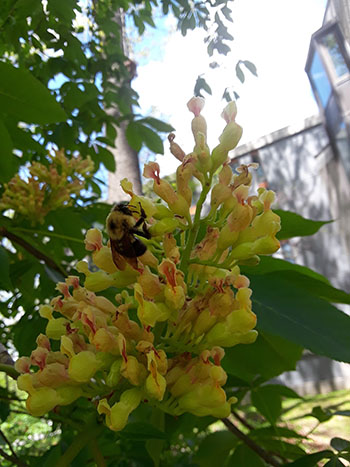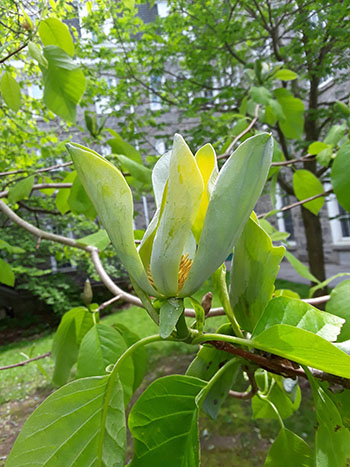
Plants of the Week: May 11

A recent interest of mine has been unsung and underutilized native plants. Chiefly, I have been smitten with the form and foliage of native Aesculus and Magnolia species. Both genera can be found throughout the Northern Hemisphere, and we are quite fortunate to have a number of species populating the East Coast and even our local woodlands. I have been especially enamored with the local Aesculus and Magnolia species which have a tropical aesthetic about them.
Aesculus flava (prev. A. octandra), known commonly as yellow buckeye, is a lovely native tree which inhabits much of the Ohio Valley and Appalachian Mountains, but is rare in the Piedmont plateau. With many unique ornamental features, A. flava is one of the showiest of the Aesculus species, though it remains rare in cultivation and lacks proper acclaim.
This tree beckons the arrival of spring in spectacular fashion. Large, glossy buds give way to luscious new leaves. The new leaves emerge in pairs, like folded wings, emerging like a butterfly from a chrysalis A. flava leaves appear early in Southeastern Pennsylvania in comparison to most natives, with foliage opening this year before the vernal equinox. The emergent foliage of A. flava comes in light green, bronze, and burgundy tones with leaves later maturing to dark green. The flowers soon follow suit with a show of their own.
The flowers are A. flava, as the common name would suggest, are yellow, and adorn the branch tips in late spring, typically in April-May. Individual flowers have a tapered tubular shape and are arranged on large erect panicles. While individual flowers are somewhat insignificant, the panicles are quite showy.
The standby ornamental feature of this tree is the foliage, which offers landscape appeal throughout the growing season. The dark green foliage of A. flava has an attractive luster and pronounced venation, making it stand out among other plants. I find the compound palmate leaf and long petiole of A. flava lend a tropical look to this native tree; when grown in part shade the branching is sparse and the leaves larger, further adding to this effect. A beautiful A. flava specimen can be found on the backside of Dana Hall, along with a number of seedlings that have moved into the Crum Woods nearby. photo credit: R. Payne-Meyer

Magnolia tripetala, or the umbrella magnolia, reaches its northern limit in Southeastern Pennsylvania, and can be found creeping through the banks of Wissahickon Valley, Schuylkill and Susquehanna rivers. This small-statured magnolia species is a sub-canopy tree which thrives in the understory of shaded hillsides and streambanks. Plants can form dense colonies in the woods, and often send up many sprouts from the trunk, giving a weedy look. A turn-off for some gardeners, this can be overcome by maintaining single stemmed specimens through pruning.
Siting trees in dappled shade facilitates a more open and airy growth form, something I personally favor for this species. This tree, along with fellow natives with M. fraseri (Fraser magnolia) and M. macrophylla (bigleaf magnolia), have a distinctly tropical look among their native hardwood forest companions. All of the native large leaved magnolias really are quite visually distinctive and I’m always ecstatic to see these plants used in gardens.
The large leaves clustered at the tip of branches, lend an umbrella-like effect, to which the common name refers. M. tripetala has recently entered its flowering period, revealing large creamy-white flowers with twelve tepals (think petals). Though many find the floral scent offensive, I personally quite enjoy the fragrance – go figure! A rather large multi-stem M. tripetala tree can be found on the south side of Trotter Hall. photo credit: R. Payne-Meyer

Another magnolia that deserves more attention and use in local landscapes is the cucumbertree magnolia, Magnolia acuminata. M. acuminata stands alone among the northern reaching magnolia species as a canopy tree, usually 40-70’ in cultivation and up to 100’ in healthy forests. Furthermore, M. acuminata is one of the most cold-hardy magnolia species. Magnolia acuminata becomes a lovely spreading shade tree when given room to grow, though it is often overlooked as a choice for residential landscapes.
Like the aforementioned trees, this species also performs well in part shade or full sun. Unlike most magnolias, it is not cherished for showy flowers; the yellow-green blooms of M. acuminata appear in late spring after foliage emerges, resting inconspicuously high atop branches. The pinkish-red fruits of M. acuminata that follow the flower resemble cucumbers, hence the common name. The leaves are large, simple and, ovate – quite attractive to my eye. M. acuminta trees become absolutely grand with age, somewhat resembling white oaks in their winter structure and bark. An attractive specimen is located on the north side of Parrish Hall, adjacent to the Isabelle Cosby Courtyard. photo credit: R. Payne-Meyer





No Comments